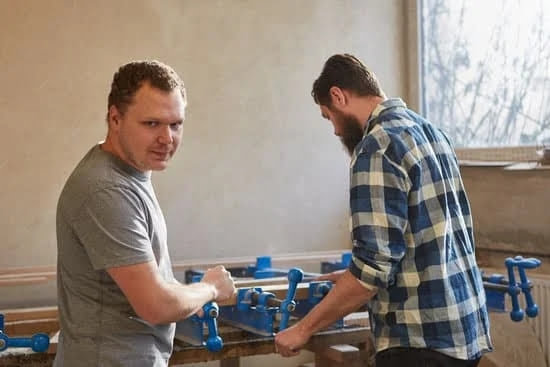Why do woodworkers not wear wedding rings? Wedding rings are traditionally worn as a symbol of commitment and love. However, in the woodworking industry, it is a common practice for woodworkers to forego wearing their wedding rings while on the job. This article seeks to explore the reasons behind this practice, from safety concerns to cultural traditions.
While wedding rings hold great significance in many cultures, they can pose significant safety hazards in certain work environments, particularly those involving machinery and physical labor. In the woodworking industry, wearing jewelry, including rings, can increase the risk of accidents and injuries.
This article will delve into the various factors that contribute to woodworkers choosing not to wear their wedding rings while working with wood and machinery. From discussing potential dangers and providing real-life examples of accidents to exploring workplace regulations and suggesting alternative options for showing commitment, we aim to shed light on this common but rarely discussed practice in the woodworking profession.
Safety Concerns
While wedding rings hold great sentimental value and signify the commitment between partners, wearing them in a woodworking environment can pose significant safety concerns. The potential dangers of wearing jewelry, especially rings, while working with wood and machinery are a primary reason why woodworkers choose not to wear wedding rings. Here are some specific safety concerns to consider:
- Ring Entrapment: Rings can get caught on protruding nails, splinters, or other rough surfaces, leading to potential finger injuries or amputations.
- Machinery Hazards: Wearing rings while operating power tools or machinery poses the risk of entanglement, as the ring can easily be pulled into moving parts, causing severe hand injuries.
- Electrical Risks: Metal rings conduct electricity and increase the likelihood of electrical shock if a woodworker comes into contact with live wires or faulty equipment.
The aforementioned dangers highlight why woodworkers prioritize safety by choosing not to wear wedding rings in their professional settings. While personal sentiment is important, the potential risks associated with wearing jewelry in a woodworking environment cannot be ignored.
In light of these safety concerns, it’s essential for woodworkers to explore alternative options that allow them to show their commitment without compromising their safety. Silicone rings have gained popularity as a safe alternative for individuals who work with their hands in potentially hazardous environments.
Furthermore, some woodworkers opt to wear their wedding ring on a chain around their neck to keep it close without putting themselves at risk. Ultimately, prioritizing safety over tradition is crucial in professions that involve working with tools and machinery.
Risks and Accidents
Woodworking can be a hazardous profession, and the risks are increased when wearing jewelry, particularly rings. Here are some real-life examples of accidents or injuries caused by wearing wedding rings in woodworking environments:
1. Finger Injuries: One common risk of wearing a wedding ring while woodworking is getting it caught in machinery or tools. This can result in serious finger injuries such as cuts, fractures, or even amputations. Many woodworkers have experienced instances where their rings were caught in rotating equipment, leading to severe consequences.
2. Skin Irritation: Another potential issue with wearing traditional metal wedding rings in woodworking is skin irritation caused by exposure to various chemicals, sawdust, and other materials often encountered in the workshop. The combination of moisture and debris trapped under the ring can lead to discomfort and dermatological problems.
3. Equipment Damage: In addition to personal harm, there is also the risk that a protruding ring could scratch or damage the surfaces of finished wood products during handling. This not only affects the quality of work but also poses financial implications for woodworkers.
While these examples highlight some of the dangers associated with wearing wedding rings while working with wood, it’s essential to consider safer alternatives that still symbolize commitment and love without compromising safety.
Ultimately, prioritizing safety should always be a top concern for woodworkers, which may mean making adjustments to conventional practices like wearing wedding rings. By being aware of the potential risks and taking proactive measures to address them, woodworkers can help prevent accidents and injuries in their craft while still honoring their commitments outside the workshop.
Workplace Regulations
OSHA Guidelines
The Occupational Safety and Health Administration (OSHA) provides guidelines and regulations to ensure the safety of workers in various industries, including woodworking. One specific regulation that directly affects woodworkers is the restriction on wearing jewelry while operating machinery or working with power tools.
This rule is primarily aimed at preventing accidents and injuries that could occur if a piece of jewelry gets caught in the machinery. As a result, many woodworking companies strictly enforce this guideline to minimize the risk of workplace accidents.
Company Policies
In addition to OSHA regulations, individual woodworking companies may have their own policies regarding the wearing of jewelry in the workplace. These policies are often put in place to reinforce safety measures and protect employees from potential harm. It is not uncommon for woodworking companies to prohibit the wearing of rings, bracelets, necklaces, or any other form of jewelry while on duty. Employees are expected to comply with these policies as part of maintaining a safe working environment.
Personal Protective Equipment (PPE)
Furthermore, the concept of personal protective equipment (PPE) also plays a role in discouraging the wearing of wedding rings among woodworkers. PPE is designed to safeguard workers from occupational hazards, and it typically includes items such as gloves, goggles, helmets, and ear protection.
Wearing rings can compromise the effectiveness of gloves by creating an uneven surface or catching on materials as woodworkers handle tools or workpieces. Considering all these safety considerations outlined by OSHA regulations and company policies, it becomes clear why woodworkers do not wear wedding rings in their daily work activities.
Alternatives
Many woodworkers face a dilemma when it comes to wearing their wedding rings while working. It is common knowledge that woodworking involves the use of heavy machinery, sharp tools, and potential exposure to various safety hazards. This has led to a widespread practice of woodworkers choosing not to wear traditional metal wedding bands during work hours. But if traditional rings are not recommended for safety purposes, what are the alternative options for woodworkers to show their commitment?
One popular alternative for woodworkers is silicone rings. These flexible rings are designed to be comfortable and safe for individuals with active lifestyles or those who work with their hands. Unlike metal rings, silicone rings are non-conductive and can break under extreme pressure, reducing the risk of injury in case of an accident. Many woodworking professionals have found these silicone bands to be a practical and safer option while still symbolizing their marriage.
Another alternative option is for woodworkers to wear their wedding ring on a chain around the neck. This method allows them to keep their ring close by without having it on their fingers while operating machinery or handling materials in the workshop. Although unconventional, wearing a wedding ring on a necklace serves as a visible reminder of one’s commitment while minimizing the safety risks associated with wearing jewelry on the hands.
It is crucial for woodworkers to prioritize safety in their profession, even when adhering to cultural or personal traditions such as wearing wedding rings. By considering alternative options like silicone rings or neck chains, individuals can maintain the symbolic significance of their marital commitment without compromising workplace safety.
| Alternative Option | Description |
|---|---|
| Silicone Rings | A flexible and non-conductive option that reduces the risk of injury in case of an accident. |
| Necklace Chain | An unconventional but safe method for keeping the wedding ring close by without wearing it on the fingers during woodworking tasks. |
Cultural and Traditions
Woodworking is a craft deeply rooted in tradition and cultural practices. In many woodworking traditions, wearing jewelry, including wedding rings, is discouraged for practical and symbolic reasons. One of the primary reasons why woodworkers do not wear wedding rings is the concern for safety. The combination of heavy machinery, hand tools, and the nature of woodworking itself presents a high risk for accidents when wearing any type of jewelry.
In some cultural traditions, including certain woodworking communities, it is believed that the presence of metal in the workspace can disrupt the natural flow of energy or create unnecessary distractions. This belief has led to a general consensus among woodworkers to refrain from wearing metal jewelry such as rings while working on woodworking projects.
Additionally, there is a strong emphasis on craftsmanship and attention to detail within the woodworking community. Wearing a traditional metal wedding ring could pose a risk not only to personal safety, but also to the quality of work produced. As such, many woodworkers choose to adhere to these cultural and woodworking traditions by opting for alternative methods to signify their commitment such as silicone rings or wearing their traditional ring on a chain around their neck.
| Reasons | Impact |
|---|---|
| Safety Concerns | High risk for accidents when wearing any type of jewelry |
| Cultural Traditions | Beliefs that presence of metal disrupts natural flow of energy or creates distractions; emphasis on craftsmanship leads woodworkers to alternative methods |
Personal Stories
As a woodworker, the decision not to wear a wedding ring while working is often based on safety concerns. Many woodworkers choose not to wear their wedding rings in the workshop due to the potential dangers associated with wearing jewelry around heavy machinery and sharp tools. While it may seem like a simple accessory, wedding rings can pose significant risks in a woodworking environment.
Real-Life Accidents and Injuries
Woodworkers have experienced various accidents and injuries caused by wearing wedding rings while working with wood and machinery. One common risk is the possibility of the ring getting caught in moving parts of equipment, potentially leading to severe finger injuries.
There have been instances where individuals have sustained serious cuts, bruises, or even lost fingers as a result of wearing a ring while engaging in woodworking activities. These unfortunate incidents serve as sobering reminders of the potential hazards associated with wearing jewelry in this profession.
Workplace Regulations and Guidelines
In many woodworking settings, there are specific regulations or guidelines that discourage or prohibit employees from wearing jewelry, including wedding rings, for safety reasons. Employers prioritize workplace safety and often implement policies to reduce the risk of accidents and injuries among their workers.
These regulations typically align with industry standards and best practices for occupational safety. As a result, woodworkers are required to comply with these rules by refraining from wearing any type of jewelry that could compromise their safety while on the job.
Woodworkers understand the importance of prioritizing safety in their profession, which is why many choose alternative options for showing their commitment to their marriage without jeopardizing their well-being. From silicone rings designed specifically for active individuals to wearing traditional metal bands on chains around their necks, there are various ways for woodworkers to honor their marital status while minimizing the potential risks associated with wearing traditional wedding rings in the workshop.
Ultimately, through personal stories and experiences, it becomes evident that safety remains paramount for woodworkers who choose not to wear wedding rings while practicing their craft.
Conclusion
In conclusion, the decision for woodworkers not to wear wedding rings is primarily rooted in the paramount importance of safety in the woodworking profession. The potential dangers of wearing jewelry, especially rings, while working with wood and machinery cannot be overlooked. The risks and accidents that have occurred serve as tangible reminders of why it is crucial for woodworkers to prioritize safety over traditional customs.
While workplace regulations and guidelines may vary, many woodworking environments discourage or prohibit the wearing of jewelry due to safety concerns. This includes wedding rings, which can pose a significant risk of getting caught in machinery or causing injury during woodworking tasks. As such, it is essential for woodworkers to adhere to these regulations and consider alternative options for displaying their commitment, such as silicone rings or wearing the ring on a chain around the neck.
At its core, the decision not to wear wedding rings in woodworking settings also reflects a cultural and traditional aspect. In some woodworking traditions, safety measures take precedence over personal preferences when it comes to attire and accessories worn in the workshop.
While individual perspectives may differ, there is an overarching understanding within the woodworking community that prioritizing safety is non-negotiable. By doing so, woodworkers are able to safeguard themselves from potential harm and continue practicing their craft with peace of mind.
Frequently Asked Questions
Why Don T Chefs Wear Wedding Rings?
Chefs don’t wear wedding rings because of food safety concerns. The presence of a ring can harbor bacteria and other contaminants, which can then be transferred to the food being prepared. To maintain a high standard of cleanliness in the kitchen and prevent any potential health risks, many chefs choose not to wear rings while working.
Why Don’t Construction Workers Wear Rings?
Construction workers typically refrain from wearing rings due to safety reasons. Wearing a ring on the job site poses a risk of getting caught on machinery or materials, potentially leading to serious injury. In order to prevent accidents and ensure their own safety, construction workers usually opt not to wear rings while working.
Why Do Electricians Not Wear Wedding Rings?
Electricians avoid wearing wedding rings while on the job for safety purposes as well. The metal band of a ring can conduct electricity and create a risk of electric shock if it comes into contact with live wires or electrical components.
Therefore, it is common practice for electricians to remove their wedding rings before working on any electrical systems in order to minimize the risk of injury or accidents.

Hi everyone! I’m a woodworker and blogger, and this is my woodworking blog. In my blog, I share tips and tricks for woodworkers of all skill levels, as well as project ideas that you can try yourself.





